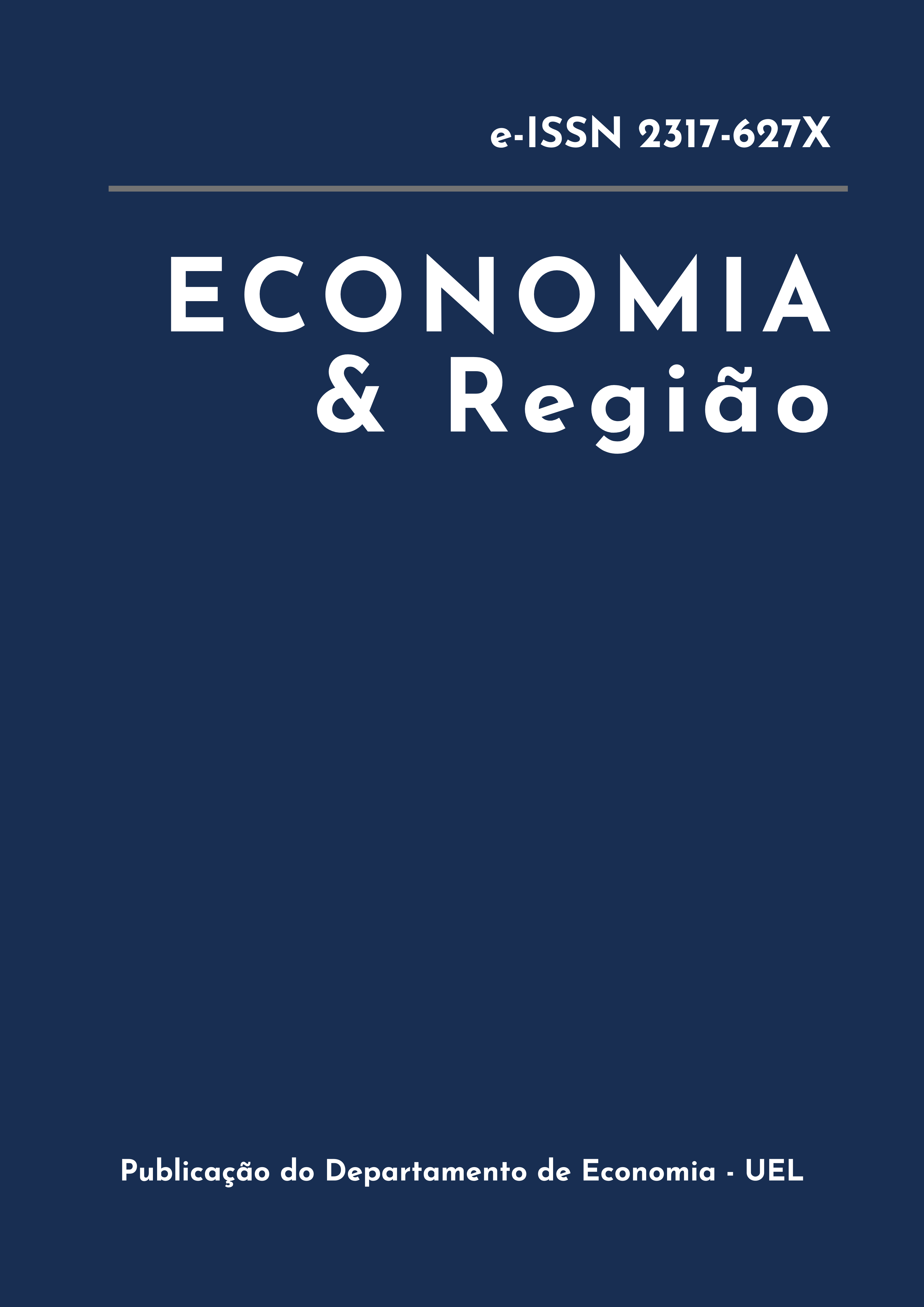La Ley de Wagner frente a la Hipótesis Keynesiana
Un Análisis para México de 1990 al 2021
DOI:
https://doi.org/10.5433/2317-627X.2024.v12.n3.49625Palabras clave:
Ley de Wagner, Hipótesis Keynesiana, crecimiento económico, gasto públicoResumen
El presente artículo tiene como objetivo realizar un contraste sobre la Ley de Wagner frente a la Hipótesis Keynesiana en México para el periodo de 1990 a 2021 con el fin de conocer la relación existente entre el crecimiento económico y el gasto público. Se elaboraron pruebas de cointegración y causalidad mediante el uso de datos de series temporales. Los resultados presentan pruebas de la existencia de una relación causal del crecimiento económico sobre el gasto público y de una cointegración a largo plazo entre ambas variables, por lo cual, dichos resultados respaldan la presencia de la Ley de Wagner en la economía mexicana para el periodo analizado.
Descargas
Citas
APARCO, E.; FLORES, A. La hipótesis keynesiana del gasto público frente a la ley de Wagner: un análisis de cointegración y causalidad para Perú. Revista de Economía del Rosario, Bogotá, v. 22, n. 1, p. 53-73, abr. 2019. DOI: https://doi.org/10.12804/revistas.urosario.edu.co/economia/a.7764. Acceso em: 18 oct. 2022. DOI: https://doi.org/10.12804/revistas.urosario.edu.co/economia/a.7764
ASHWORTH, J. Spurious in Mexico: a comment on Wagner’s law. Public Finance, Chicago, v. 49, n. 2, p. 282-286, 1994. Disponible en: https://ideas.repec.org/a/pfi/pubfin/v49y1994i2p282-86.html. Acceso en:18 oct. 2022.
BIRD, R. M. Wagner's law of expanding state activity. Public Finance, Chicago, v. 26, n. 1, p. 1-26, 1971. Disponible en: https://www.researchgate.net/publication/226647729_Wagner's_Law_of_Expanding_State_Activity#:~:text=Bird%20(1971)%20outlined%20the%20reasons,legal%20system%3B%20(b)%20real. Acceso em: 20 nov. 2022.
CAMARGO, A. I.; GONZÁLEZ FAVILA, M. A. Gasto De gobierno y crecimiento económico en México, cambios de régimen y causalidad asimétrica. Cuadernos de Economía, Bogotá, v. 45, n. 127, p. 92-105, enero 2022. DOI: https://doi.org/10.32826/cude.v1i127.608.
CHICK, V. Macroeconomics after Keynes: a reconsideration of the general theory. Cambridge: The MIT Press, 1983.
CONAPO - CONSEJO NACIONAL DE POBLACIÓN. Obtenido de datos abiertos. [Cidade do México]: CONAPO, 2021. Disponible en: https://datos.gob.mx/busca/dataset/proyecciones-de-la-poblacion-de-mexico-y-de-las-entidades-federativas-2016-2050/resource/b29b9649-72bc-48e7-9edd-c385b0f450e8. Acceso en: 27 nov. 2022.
GALINDO, L.; CORDERA, R. Las relaciones de causalidad entre el gasto público y el producto en México: ¿existe evidencia de cambio estructural?. Revista Mexicana de Economía y Finanzas, Ciudad de México, v. 4, n. 4, p. 369-386, 2005. DOI: https://doi.org/10.21919/remef.v4i4.211. DOI: https://doi.org/10.21919/remef.v4i4.211
GOFFMAN, I. On the empirical testing of Wagner’s law: a technical note. Heslington: Public Finance, Chicago, v. 23, n. 3, p. 359-364, 1968.
GUJARATI, D. N. Principios de econometría. Ciudad de México: Mcgraw Hill, 2006.
GUJARATI, D. N.; PORTER, D. C. Econometría. 5. ed. Ciudad de México: Mcgraw-Hill Interamericana, 2009.
GUPTA, S. Public expenditure and economic growth: a time series analysis. Public Finance, Chicago, v. 22, p. 423-461, 1967.
HAYO, B. No further evidence of Wagner’s law for Mexico. Public Finance, Chicago, v. 49, n. 2, p. 287-294, 1994. Disponible en: https://ideas.repec.org/a/pfi/pubfin/v49y1994i2p287-94.html. Acceso en: 28 oct. 2022
HICKS, J. R. (1937). Mr. Keynes and the" classics"; a suggested interpretation. Econometrica, Chicago, v. 5, n. 2, p. 147-159, Apr., 1937.
INEGI. Producto interno bruto trimestral: año base 2013. Aguascalientes: INEGI, 2021. Disponible en: https://www.inegi.org.mx/app/tabulados/default.aspx?pr=38&vr=5&in=2&tp=20&wr=1&cno=2&idrt=12008&opc=p. Acceso en: 27 nov. 2022
IÑIGUEZ-MONTIEL, A. Government expenditure and national income in Mexico: Keynes versus Wagner. Applied Economics Letters, Abingdon, v. 17, n. 9, p. 887-893, 2010. DOI: https://doi.org/10.1080/13504850802599433. DOI: https://doi.org/10.1080/13504850802599433
JAÉN GARCÍA, M. La ley de Wagner: un análisis sintético. Madrid: Instituto de Estudios Fiscales, 1998. (Papeles de Trabajo, n. 6/04).
JOHANSEN, S. Statistical analysis of cointegration vectors. Journal of Economic Dynamics and Control, Amsterdam, v. 12, n. 2-3, p. 231-254, june/sept. 1988. DOI: https://doi.org/10.1016/0165-1889(88)90041-3. DOI: https://doi.org/10.1016/0165-1889(88)90041-3
KALDOR, N. The case for regional policies. Scottish Journal of Political Economy, Hoboken, v. 60, n. 5, p. 481-491, Nov. 2013. DOI: https://doi.org/10.1111/sjpe.12020. DOI: https://doi.org/10.1111/sjpe.12020
KALDOR, N. La economía keynesiana cincuenta años después. Investigación Económica, Ciudad de México, v. 46, n. 181, p. 13-66, 2016. Disponible en: https://biblat.unam.mx/hevila/Investigacioneconomica/1987/vol46/no181/2.pdf. Acceso en: 28 oct. 2022.
KEYNES, J. M. The general theory of employment, interest and money. Londres: Macmillan, 1936.
KOOP, G. Analysis of economic data. 4th. ed. New York: John Wiley & Sons, 2013.
KRUGMAN, P. R. Economía internacional. 8. ed. Madrid: Pearson Educación, 2009.
LIN, C. More evidence on Wagner’s law for Mexico. Public Finance, Chicago, v. 50, n. 2, p. 267-277, 1995. Disponible en: https://ideas.repec.org/a/pfi/pubfin/v50y1995i2p267-77.html. Acceso en: 17 nov. 2022
LUCAS, R. E. On the mechanics of economic development. Journal of Monetary Economics, Amsterdam, v. 22, n. 1, p. 3-42, July 1988. DOI: https://doi.org/10.1016/0304-3932(88)90168-7 DOI: https://doi.org/10.1016/0304-3932(88)90168-7
MANKIW, N. G. Principles of economics. 9th ed. Independence,KY: Cengage, 2021.
MANN, A. Wagner’s law: an econometric test for Mexico, 1925–1976. National Tax Journal, Washington, D. C, v. 33, n. 2, p. 189-201, 1980. DOI: https://doi.org/10.1086/ntj41862301. DOI: https://doi.org/10.1086/NTJ41862301
MATA, H. Nociones elementales de cointegración enfoque de Soren Johansen. Mérida: Universidad de los Andes, 2008.
MURTHY, N. Further evidence of Wagner’s law for Mexico: an application of cointegration analysis. Public Finance, Chicago, v. 48, n. 1, p. 92-96, 1993. Disponible en: https://ideas.repec.org/a/pfi/pubfin/v48y1993i1p92-96.html. Acceso en: 26 oct. 2022.
MURTHY, N. Wagner’s law, spurious in Mexico or misspecification: a reply. Public Finance, Chicago, v. 49, n. 2, p. 295–303, 1994. Disponible en: https://ideas.repec.org/a/pfi/pubfin/v49y1994i2p295-303.html. Acceso en: 26 oct. 2022
MUSGRAVE, R. A. Fiscal systems. New Haven: Yale University Press, 1969.
NAGARAJAN, P.; SPEARS, A. An econometric test of Wagner´S law for Mexico: a reexamination. Public Finance, Chicago, v. 45, n. 1, p. 167-178, 1990. Disponible en: https://ideas.repec.org/a/pfi/pubfin/v45y1990i1p165-68.html. Acceso en: 26 oct. 2022
PEACOCK, A. T.; WISEMAN, J. The growth of public expenditure in the United Kingdom. Princeton: Princeton University Press, 1961.
PRESNO, M. J. Contrastes de Estacionariedad en Series con un Cambio en la Media. Revista de Economía Aplicada, Zaragoza, v. 10, n. 29, p. 107-134, 2002.
RAMÍREZ CEDILLO, E. La política fiscal desde una perspectiva de crecimiento endógeno, equilibrio presupuestal y fluctuaciones de Corto Plazo. problemas del desarrollo. Problemas del Desarrollo: Revista Latinoamericana de Economía, Ciudad de México, v. 39, n. 152, p. 113-137, ene./mar. 2008. DOI: https://doi.org/10.22201/iiec.20078951e.2008.152.7704
RODRÍGUEZ, D.; LÓPEZ-HERRERA, F. Desarrollo económico y gasto público de las entidades federativas en México: análisis de cointegración en panel y la ley de Wagner. Gestión y Política Pública, Ciudad de México, v. 22, n. 2, p. 299-330, jul./dic. 2014. Disponible en: https://www.scielo.org.mx/scielo.php?pid=S1405-10792014000200001&script=sci_abstract. Acceso en:
RODRÍGUEZ, D.; VENEGAS-MARTÍNEZ, F.; LIMA, V. La ley de Wagner versus la hipótesis keynesiana: el caso de México, 1950-2009. Investigación Económica, Ciudad de México, v. 72, n. 283, p. 69-98, 2013. DOI: https://doi.org/10.1016/s0185-1667(13)72587-6. DOI: https://doi.org/10.1016/S0185-1667(13)72587-6
ROMER, P. M. Increasing returns and long-run growth. Journal of Political Economy, Chicago, v. 94, n. 5, p. 1002-1037, Oct. 1986. DOI: https://doi.org/10.1086/261420. DOI: https://doi.org/10.1086/261420
ROMER, P. M. Are nonconvexities important for understanding growth? The American Economic Review, Nashville, v. 80, n. 2, p. 97-103, May 1990. DOI: https://www.jstor.org/stable/2006550.
ROS, J. La teoría general de Keynes y la macroeconomía moderna. Investigación Económica, Ciudad de México, v. 71, n. 279, p. 19-37, 2012. DOI: https://doi.org/10.22201/fe.01851667p.2012.279.37327. DOI: https://doi.org/10.22201/fe.01851667p.2012.279.37327
SAMUELSON, P. A. Consumption theory in terms of revealed preference. Economica, [S. l.], v. 15, n. 60, p. 243-253, Nov. 1948. DOI: https://doi.org/10.2307/2549561. DOI: https://doi.org/10.2307/2549561
SÁNCHEZ-JUÁREZ, I.; GARCÍA ALMADA, R. M.; BARAJAS BUSTILLOS, H. The relationship between total production and public spending in Mexico: Keynes versus Wagner. International Journal of Financial Research, Los Angeles, v. 7, n. 1, p. 109-120, 2016. DOI: http://dx.doi.org/10.5430/ijfr.v7n1p109. DOI: https://doi.org/10.5430/ijfr.v7n1p109
SECRETARÍA DE HACIENDA Y CRÉDITO PÚBLICO. Estadísticas oportunas de finanzas públicas. [S. l.: s. n.], [2021]. Disponible en: http://presto.hacienda.gob.mx/EstoporLayout/. Acceso en: 27 nov. 2022.
SIDERIS, D. Wagner's law in 19th century Greece: a cointegration and causality analysis. Bank of Greece, Αthens, n. 64, p. 1-19, Dec. 2007. DOI: https://doi.org/10.2139/ssrn.4164000. DOI: https://doi.org/10.2139/ssrn.4164000
SOLOW, R. M. A skeptical note on the constancy of relative shares. The American Economic Review, Nashville, v. 48, n. 4, p. 618-631, Sept. 1958. DOI: https://www.jstor.org/stable/1808271
WAGNER, A. Finanzwissenschaft. Leipzig: C.F. Winter, 1890.
Descargas
Publicado
Cómo citar
Número
Sección
Licencia
Derechos de autor 2024 Eleazar Benitez Obregón, Arnoldo Eluzaim Rodríguez Sánchez, Francisco Garcia Fernandez, Jesús Gerardo Delgado Rivas

Esta obra está bajo una licencia internacional Creative Commons Atribución 4.0.
Economia & Região adota a Licença Creative Commons Attribution CC-BY 4.0 International, portanto, os direitos autorais relativos aos artigos publicados são do(s) autor(es), que cedem à Revista Economia & Região o direito de exclusividade de primeira publicação.
Sob essa licença é possível: Compartilhar - copiar e redistribuir o material em qualquer suporte ou formato. Adaptar - remixar, transformar, e criar a partir do material, atribuindo o devido crédito e prover um link para a licença e indicar se mudanças foram feitas.
















